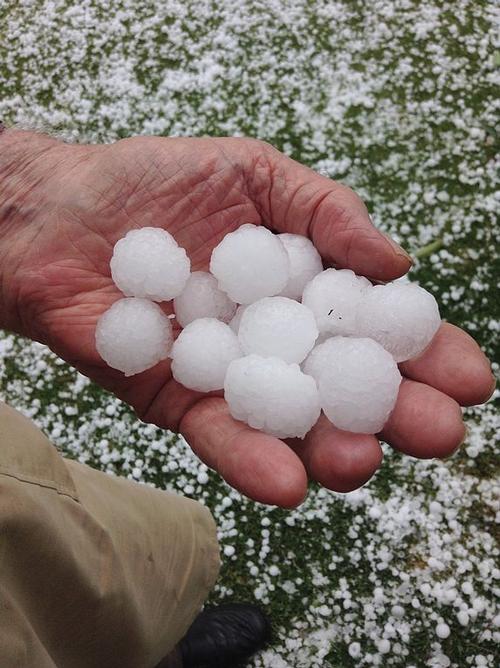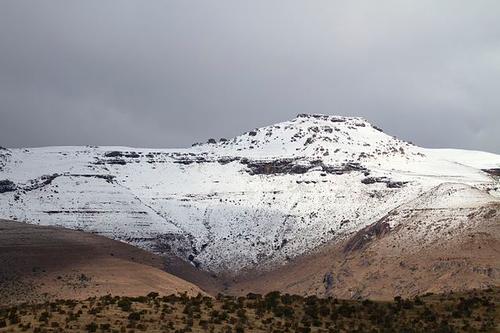SOUTH AFRICA
Climate and Weather

Climate and Weather

Cities in SOUTH AFRICA
| Cape town | Johannesburg |
Climate and Weather
Due to its location south of the equator, the South African summer starts in December and winter in June.
Despite the country's enormous size, the climate is relatively uniform and temperate. This applies in particular to the temperature in the interior, which is due to the fact that at lower latitudes the height is generally greater than further south. Typically, the average temperature in Cape Town is 16.5 °C and in much more northern Johannesburg 16.2 °C.
 Handful of hailstones in Pretoria, Northern part ofSouth AfricaPhoto: Bernard Brönn CC 4.0 International no changes made
Handful of hailstones in Pretoria, Northern part ofSouth AfricaPhoto: Bernard Brönn CC 4.0 International no changes made
It is warmest on the east coast with an average temperature of 20.6 °C in Durban. During the day, it averages 27 °C to 22 °C in winter in Durban in summer. The temperature on the west coast is kept evenly low by the cold Benguela Current, the temperature on the east coast is kept evenly high by the warm Agulhas Current.
The hottest month in the interior is January and the hottest month on the coast is February. Even in winter it is still around 20 °C in most places. In the north, October and November are warm months due to the summer rains. In the higher inland it freezes regularly, in the mountainous southeast even more than 100 nights a year. Due to the average low humidity, there is often no more than a thin layer of snow.
 Thin layer of snow on Bankberg Mountains, Eastern Cape, South AfricaPhoto: Leo za1 CC 3.0 Unported no changes made
Thin layer of snow on Bankberg Mountains, Eastern Cape, South AfricaPhoto: Leo za1 CC 3.0 Unported no changes made
In two thirds of South Africa, less than 500 mm of precipitation falls annually. Most of the precipitation in South Africa falls in summer time, when the humid air of the Indian Ocean flows inland forcefully. In Cape Town, on the other hand, most precipitation falls in the months of June to September. The rain often falls in short heavy showers in the summer, after which the sun shines quickly.
West of the eastern mountain ridges receives the least rain, in the rest of the country there is generally a constant amount of rainfall, about 1000mm per year. Except for the southern part of the country, under the influence of disturbances the most precipitation falls in the winter season and a moderate rain climate prevails. The east coast in the south has dry winters. To the west it is getting drier and in the central part there is even a steppe climate with about 100mm per year in the Kalahari desert. In cities such as Bloemfontein and Kimberley in the central part of South Africa, temperatures of 30 °C are easily reached in January and February.
 Burning sun on the Kalahari Desert, Northern Cape, South AfricaPhoto: South African Tourism CC 2.0 Generic no changes made
Burning sun on the Kalahari Desert, Northern Cape, South AfricaPhoto: South African Tourism CC 2.0 Generic no changes made
The number of sun hours is very high, for example in comparison to the Iberian peninsula. In Madrid the sun shines an average of 2910 hours per year and in Lisbon 2740 hours. In South Africa, Cape Town has an average of 2,980 hours and Pretoria 3,240 hours per year. Coastal towns of the Cape Province and KwaZulu / Natal receive an average of 300 hours of sunshine more than the Canary Islands.
Sources
Dekker, M. / Zuid-Afrika
Gottmer/Becht
Luirink, B. / Zuid-Afrika : mensen, politiek, economie, cultuur, milieu
Koninklijk Instituut voor de Tropen,
Moerkamp, J. / Zuid-Afrika
ANWB
Schaap, D. / Zuid-Afrika
Minbuza Kosmos-Z&K
Zuid-Afrika
Cambium
CIA - World Factbook
BBC - Country Profiles
Last updated June 2025Copyright: Team The World of Info